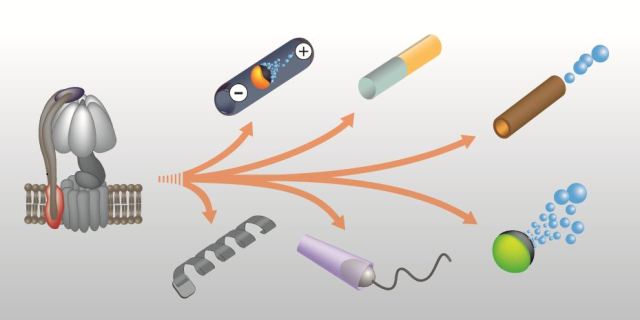May 28 2014
Researchers from the ICN2 Nanobioelectronics and Biosensors Group, led by ICREA Research Professor Arben Merkoçi, publish an extensive review in Chemical Reviews about these ultra-small devices with an extraordinary potential.

Nano- and micromotors are ultra-small devices designed to perform selected mechanical movements in response to specific stimuli. These movements include rotation, rolling, shuttling, delivery, contraction or collective behaviour, depending on the design of the motor and its biologically or chemically functionalized components.
Nano and Micromotors at ICN2
These devices are principally characterized according to the type of energy input that they use, as their operating mechanism is strongly related to the energy source. It can be fuel (natural or synthetic), or a physical source (e.g., light, magnetic fields, electric fields, or ultrasonic acoustic waves). Nano- and micromotors are often mimics of natural biological motors.
Researchers from the Nanobioelectronics and BiosensorsGroup at the InstitutCatalà de NanociènciaiNanotecnologia (ICN2) have recently published an extensive review in Chemical Reviews entitled “Nano/Micromotors in (Bio)chemical Science Applications”. The authors of this work, summarizing the state-of-the art knowledge about the design of such devices for biological and chemical applications, are Dr.Maria Guix, Dr.Carmen C. Mayorga-Martinez, and Prof.Arben Merkoçi, ICREA Research Professor and Group Leader at ICN2.
Over the past decade, researchers have shown increased interest in nano- and micromotors. After preliminary works which constituted a proof of concept, research in this area is progressing into specific applications for areas such as biomedicine (e.g., diagnostics), environmental monitoring and remediation, food safety, and security.
The review explains examples of natural biological motors, like those present in the cytoskeleton, the DNA- or RNA-processing enzymes or the bacterial rotary flagellarmotors,which have inspired several engineered nano- and micromotors. After that, the authors highlight the latest achievements in synthetic motors, including catalytic nanomotors based on various chemical or biochemical fuels, and discuss the respective limitations of these devices. Their movement depends on an external source (light, magnetic or electric fields, or ultrasonic waves). Finally, the review provides an overview of hybrid motors, which integrate natural biological parts with synthetic components across a range of materials and functionalities.
The article concludes that nano- and micromotors offer extraordinary potential for future biochemical and biomedical applications. Various energy sources have been explored to increase the lifetime of these devices and make them compatible with in vivo applications. The final goal is the remote operation of nano- and micromotors in the human body as fully controllable nanorobots, but right now it still belongs to science fiction literature. The next years of research will be crucial to determine if these dreamt devices will become real.
Article Reference:
Guix M, Mayorga-Martinez CC, Merkoçi A. Nano/Micromotors in (Bio)chemical Science Applications. Chem Rev. 2014 May 14. [Epub ahead of print]
http://pubs.acs.org/doi/full/10.1021/cr400273r